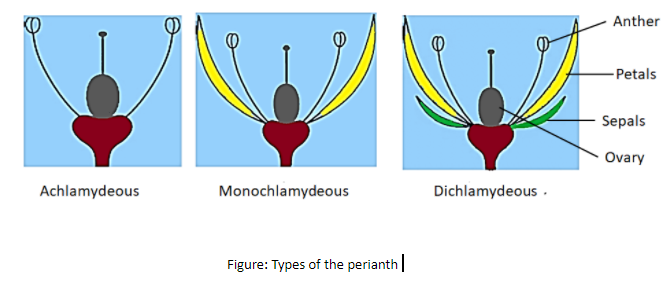
Explain the term perianth.
Answer
501.6k+ views
Hint: It is the non-reproductive part of the flower that forms an envelope surrounding the sexual parts of flowers.
Complete step-by-step answer:
Calyx and corolla are collectively called the perianth. Perianth enclosed the reproductive part of flowers. It is divided into outer and inner whorls. The sepals are the outermost layer which is usually green and encloses the flower bud. They are collectively called the calyx. However, the petals are the next layer of floral appendages internal to the calyx. The sepals and petals in flowers are accessory parts or sterile appendages that protect the flower buds and attract pollinators.
In some plants, the calyx and corolla are separately called dichlamydeous while in some plants they both are indistinguishable and called monochlamydeous. A flower without perianth is called achlamydeous. If the perianth is not differentiated into the calyx and the corolla, called perigon.
The symmetry of flowers decided by the perianth. When the perianth is bisected over the central axis from any point the symmetrical halves are produced, the flower is called actinomorphic. When flowers are bisected and produce only one line that produces symmetrical halves, called zygomorphic.
Types of perianth:
Aposepalous: When the sepals are free, the calyx is called aposepalous.
Synsepalous: If the sepals are partially or wholly fused, the calyx is called as synsepalous.
Asepalous: A flower without calyx is called as asepalous
Sympetalous: The petals are united to form a tubular corolla, called sympetalous.
Apopetalus: If the petals are free, the corolla is called apopetalous.

Note: -In the mosses and liverworts, the perianth is the sterile tube-like tissue that surrounds the female reproductive structure.
-In flowers, sepals and petals are collectively called tepals.
Complete step-by-step answer:
Calyx and corolla are collectively called the perianth. Perianth enclosed the reproductive part of flowers. It is divided into outer and inner whorls. The sepals are the outermost layer which is usually green and encloses the flower bud. They are collectively called the calyx. However, the petals are the next layer of floral appendages internal to the calyx. The sepals and petals in flowers are accessory parts or sterile appendages that protect the flower buds and attract pollinators.
In some plants, the calyx and corolla are separately called dichlamydeous while in some plants they both are indistinguishable and called monochlamydeous. A flower without perianth is called achlamydeous. If the perianth is not differentiated into the calyx and the corolla, called perigon.
The symmetry of flowers decided by the perianth. When the perianth is bisected over the central axis from any point the symmetrical halves are produced, the flower is called actinomorphic. When flowers are bisected and produce only one line that produces symmetrical halves, called zygomorphic.
Types of perianth:
Aposepalous: When the sepals are free, the calyx is called aposepalous.
Synsepalous: If the sepals are partially or wholly fused, the calyx is called as synsepalous.
Asepalous: A flower without calyx is called as asepalous
Sympetalous: The petals are united to form a tubular corolla, called sympetalous.
Apopetalus: If the petals are free, the corolla is called apopetalous.

Note: -In the mosses and liverworts, the perianth is the sterile tube-like tissue that surrounds the female reproductive structure.
-In flowers, sepals and petals are collectively called tepals.
Recently Updated Pages
Express the following as a fraction and simplify a class 7 maths CBSE

The length and width of a rectangle are in ratio of class 7 maths CBSE

The ratio of the income to the expenditure of a family class 7 maths CBSE

How do you write 025 million in scientific notatio class 7 maths CBSE

How do you convert 295 meters per second to kilometers class 7 maths CBSE

Write the following in Roman numerals 25819 class 7 maths CBSE

Trending doubts
State and prove Bernoullis theorem class 11 physics CBSE

What are Quantum numbers Explain the quantum number class 11 chemistry CBSE

Write the differences between monocot plants and dicot class 11 biology CBSE

1 ton equals to A 100 kg B 1000 kg C 10 kg D 10000 class 11 physics CBSE

State the laws of reflection of light

One Metric ton is equal to kg A 10000 B 1000 C 100 class 11 physics CBSE




